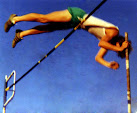This photograph shows vaulter Thierry Vigneron's form. Vigneron was the first vaulter to surpass the 19-foot mark. From the 1980s to today, Vigneron established a standard for world-class vaulting recognition.
 |
| Thierry Vigneron, first vaulter to surpass 19-foot mark. Photo from page 81 Ganslen Mechanics of the Pole Vault, 9th edition. |
I read and reread the responses to Ganslen's Questionnaire for World-Ranking Vaulters. Over the course of time, it has been interesting to see how vaulters Thierry Vigneron, Wladyslaw Kozakiewicz, and Billy Olson were thinking prior to their highest achievements. Twenty-one top-class vaulters answered the following questions:
- What is your second best track event? Have you competed in any other sports? (Most participated in other track events and some played group sports.)
- What weight test pole are you now using? Do you change poles regularly in competition? What conditions would motivate you to go to a softer or stiffer pole?
- Do you change your handgrip very much in competition?
- What is your approximate handspread on the pole at the take-off? Do you shift your hands anytime prior to the plant? Can the hand itself be a source of trouble to a vaulter, if so when?
- Describe carefully what you try to do when you execute your pole plant. Since this is the most important part of the vault, try to be as accurate as possible.
- Do you have any special training exercises you use to perfect your pole plant? Describe carefully.
- Is there any special exercise used off the track that will help the vaulter develop his plant technique?
- In the pole plant how do you control the pressure you apply to the pole with the lower arm? Are you conscious of the pressure of the left arm during the planting action? How does too much or too little pressure affect your vault and subsequent actions?
- In the take-off action from the ground, how do you control the action of your legs? Do you concentrate your attention on any specific leg action, its direction, bending, etc.?
- What are your cues (kinesthetic or visual) for getting yourself into a well rocked-back position on the pole? How do you try to blend your swing and rock-back action?
- In delaying the pull-up and turn do you have any cues or techniques you use to help you stay low on the pole and hold your position while waiting for the pole to react?
- In the 8th edition of Mechanics of the Pole Vault, I (Ganslen) introduced the new concept of "penetration" in pole vaulting. This discussion was also reproduced in greater detail with illustration in Athletic Journal for March 1974. By penetration, I mean the ability of the vaulter to utilize his speed in the correct manner through his swing and other actions to still retain sufficient momentum to clear the bar and avoid stalling out. We know that stalling out is one of the most common and dangerous faults in pole vaulting resulting often in a vertical uncontrolled fall into the trough or box. In your opinion what are three or four major causes of the athletes failure to achieve good penetration?
- Do you work on any particular type of clearance style over the bar?
- In your personal opinion what are three or four major faults which hold back the progress of young vaulters (exclusive of the lack of coaching help)?
- In a short paragraph, describe your training or conditioning program.
- A vaulter jumping 17-feet 6-inches writes that he has trouble with the collapse of his left arm on take-off and finds his head - very early - too close to the pole. What is the possible diagnosis?
- A young high school vaulter finds it difficult to get the pole planted high when running fast, but no trouble if he runs slowly, but now lacks momentum/penetration. What are your suggestions?
- At take-off a young vaulter has trouble with the sliding of his top hand. In addition to confidence, what are some of the techniques for successful utilization of a higher (new) grip for the younger vaulter?
- A young vaulter easily gets hips up to the bar but can only clear about 8-inches above the handgrip of 15-feet. What action is she/he failing to execute properly?
I enjoyed reading all the vaulter's responses - among the ones participating was my great friend Mike Cotton (1973 USA Champion Pole Vaulter). Many responses which may have seemed unusual at the time have led to today's preferred/accepted pole vault techniques. Ganslen's discussion of pole-loading and pole profile seemed revolutionary at the time, but today it is common knowledge that factors such as pole-bend and actual pole manufacture or design do greatly affect a vaulter's take-off and impact the bending characteristics of a vaulting pole.
Dr. Ganslen coined the pole-vaulting phrase "penetration" and defined the concept on page 27 of Mechanics of the Pole Vault: Penetration - the ability of the vaulter to convert the energy of his run plant and take-off into forward upward momentum with a minimum loss of forward speed so that the vaulter still has energy to clear the bar without "stalling out". (Note Question 12 above.)
As a final note to this Mechanics of the Pole Vault post, here are Ganslen's Three Keys for Facilitating Optimal Penetration in the Pole Vault:
- Achieve excellent run-speed, running all the way through the take-off.
- Achieve good drive with the free leg and spring forward at take-off.
- Achieve the proper take-off position (holding a tall, chest-up-and-forward posture - at highest controllable speed).

No comments:
Post a Comment
Your comments help generate intelligent pole vault discussion. I appreciate your point of view and try to answer all comments.